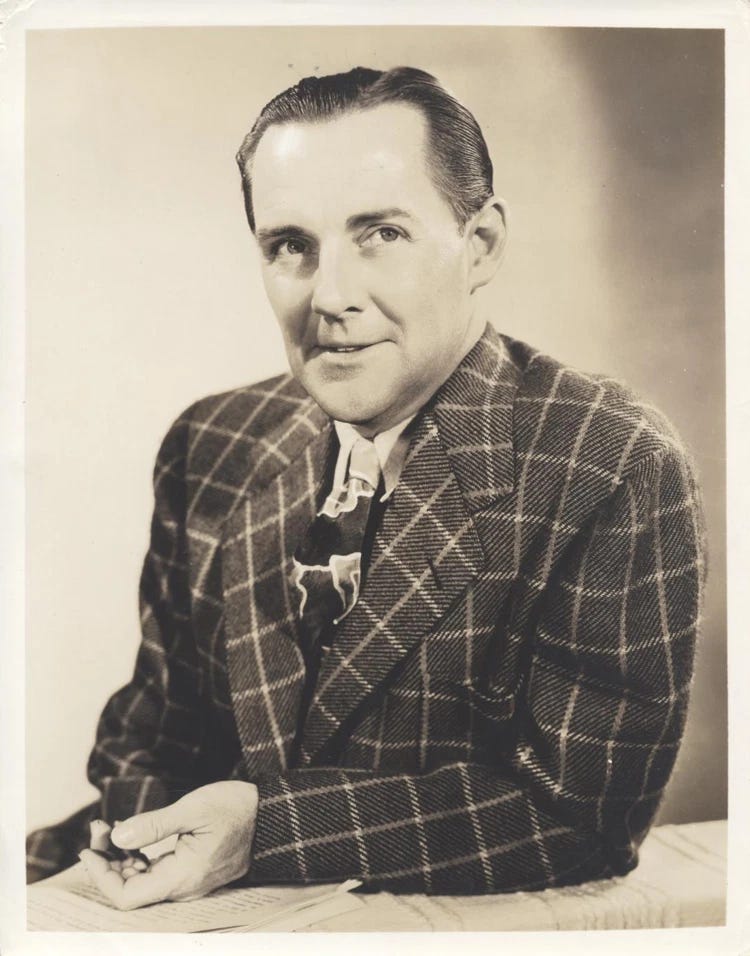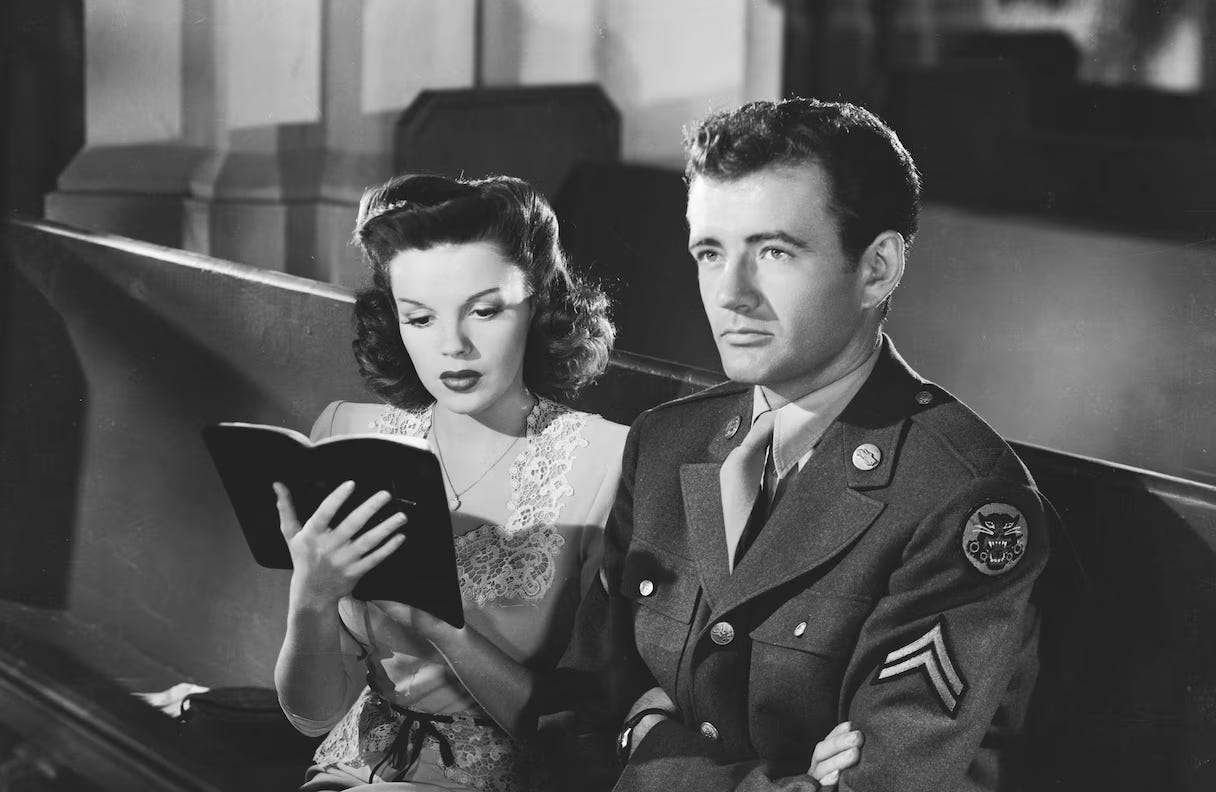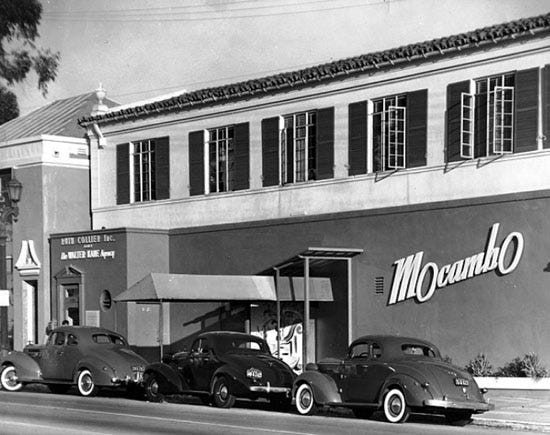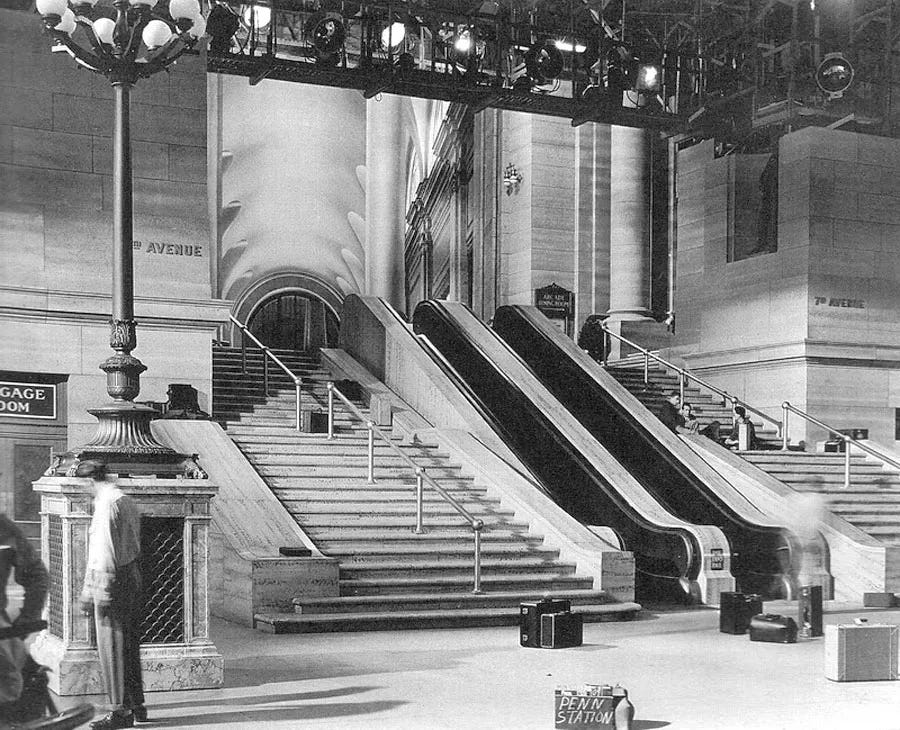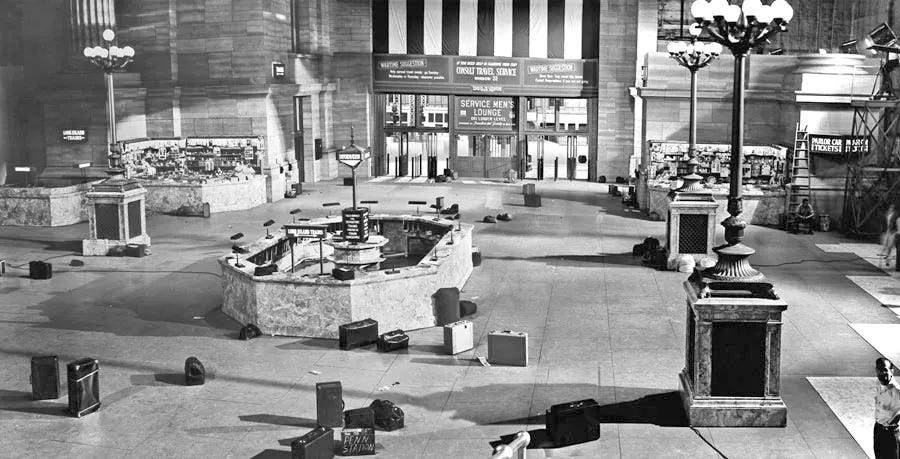It may be my imagination, but the Post-Crescent seems to have had a little more room for movie news in the month of July. After Roosevelt’s death in April, the surrender of the Nazis in May, and the ratification of the new U. N. charter in June, there must have been a real need for some kind of entertainment – and for some distraction, too.
In any case, most of Appleton’s movie news came from a columnist named Jimmie Fidler. Though almost entirely forgotten today, Fidler was a very big deal in the 1940s and ‘50s. In addition to his “Movieland” column, he hosted a radio show, broadcast live from the Roosevelt Hotel, which was by 1950 reaching around 40 million listeners.
Headline for Jimmie Fidler’s “Movieland” column, Appleton Post-Crescent, July 19, 1945, p. 4
Through the month of July, six of Fidler’s columns appeared in our local paper. Those columns still make interesting reading, not least because they work so hard to undercut the image of Hollywood as exotic, foreign, and somehow un-American.
The columns poke gentle fun at big stars and tell cute stories about beloved character actors. After getting new dentures, Guy Kibbee turns down a script in which his character never smiles. After having a tonsillectomy, Marjorie Main worries that her voice will lose its distinctive rasp; she calls a friend who mistakes her for Andy Devine, and her mind is set at ease.
More tellingly, these columns celebrate people who have contributed to the war effort and take aim at those who “ducked” service. They express contempt for Hollywood tax cheats and also share a sense of dismay at the outrageous salaries of performers who did not “work long years for their success” but instead “had it poured into their pockets overnight.”
The columns also offer praise to stars who choose domestic bliss over professional success. Though Joan Crawford has been criticized for retreating to “the privacy of her own home,” Fidler insists that she has made the right choice, noting that she has “at last achieved the happiness she sought so long to find.” With a husband and two kids, Fidler adds, Crawford now has the time to manage her household “personally.” (I know, I know — Mommie Dearest!)
It doesn’t stop there. In one of the July columns, Fidler agrees with a woman from Atlanta, the president of her local “Better Films Committee,” who thinks that gangster pictures like Dillinger are a bad influence on young men and boys. In another column, he offers his support for the “lowly horse opera,” explaining that Westerns “teach the gospel of Americanism” and “might undo some of the damage to youthful minds that has resulted from far too many sex, drunkenness, crime and divorce pictures.”
Radio host and columnist Jimmie Fidler
A couple of other things deserve closer attention. The first is Fidler’s insistence, given most explicitly in his July 16 column on the Western, that he is “an independent columnist and radio commentator without studio ties.” “Heaven forbid that I ever become involved in picture-making,” he says. “If I were part and parcel of any or all studios, my hands would be bound; I could no longer write as frankly as at present.” Fidler is, then, our man in Hollywood – an insider, for sure, but something of an outsider as well.
The other thing worth mentioning here is that Fidler’s columns occasionally include brief recommendations – the closest things to movie reviews that I’ve been able to find anywhere in the Post-Crescent. Organized under the heading “Preview Nights,” these recommendations begin with a “Pic of the Week” and then move steadily downhill. Here’s the rundown from Fidler’s column of July 19:
Pic of the Week: MGM’s “Her Highness and the Bellboy” (Robert Walker – Hedy Lamarr – June Allyson). A modern fairy tale to delight the 6-to-60 group. . . . RECOMMENDED: Paramount’s “Out of This World.” (Eddie Bracken – Veronica Lake – Diana Lynn). Bracken ties a can to Sinatra’s wall. . . . SO-SO: Columbia’s “Boston Blackie’s Rendezvous.” Less entertaining than a dental appointment. . . . BEST PERFORMANCE: Robert Walker out-steps stiff competition to cop “Her Highness and the Bellboy” acting honors.
Good stuff — but unfortunately of no immediate use to Post-Crescent readers. Here Fidler’s talking about new releases, films unlikely to reach Appleton for quite a while. On the evening of July 19, most of the movies in town had been in circulation for the better part of a year. For the record, those films were as follows:
At the Appleton: The Clock (Judy Garland – Robert Walker) and Blonde Fever (Philip Dorn – Mary Astor)
At the Elite: Objective Burma (Errol Flynn) and Roaring Guns (Robert Shayne)
At the Rio: The Unseen (Joel McCrea – Gail Russell) and The Big Show-Off (Arthur Lake – Dale Evans)
At the Viking: Irish Eyes Are Smiling (Monty Woolley – June Haver) and Woman in the Window (Edward G. Robinson – Joan Bennett)
And at the Varsity: Waterloo Bridge (Vivien Leigh – Robert Taylor) and Maisie Goes to Reno (Ann Sothern – John Hodiak)
So if Appletonians couldn’t do much with Fidler’s recommendations, at least not right away, that leaves open the question of where they might have found reviews or picked up recommendations. Could you get something like that at the library? On the radio? Over the proverbial back porch?
Thinking about these questions might also make us wonder how many local moviegoers would have cared about reviews in the first place. Mid-forties advertising campaigns almost never include blurbs or quotes from reviewers, focusing instead on the cast and the story. Familiar names and faces – Garland, Flynn, McCrea – seem to have been a small-town exhibitor’s best bets. Here’s a quick example, an ad for Salty O’Rourke, an Alan Ladd picture on its way to the Rio.
From the Appleton Post-Crescent, Thursday, July 19, 1945, page 4
Alan Ladd is the main attraction here, with Gail Russell clearly playing second fiddle. The supporting cast is mentioned in the ad, with William Demarest getting his due at the top of that list. The ad includes a picture of an actor wearing jockey’s silks, and a little bit of internet research suggests that he is Stanley Clements, helpfully identified for the audience as the “‘Going My Way’ roughneck.” People needed to know who was in the picture, it seems, right down to the guy who was sixth on the call sheet.
Just so you know, Salty O’Rourke was released by Paramount on March 22, 1945. As the year goes on, I’ll be on the lookout for the films mentioned in Jimmie Fidler’s mid-July preview. It’ll be fun to see if and when they ever turn up in Appleton . . .
+ + +
While I’ve got a chance, I want to say a few things about The Clock.
When I saw it on the list of choices for July 19, I was delighted. It’s one of my favorite films from the period – and if you’ve ever seen it, I’m guessing you feel the same way. Released by MGM in late May, it’s got Judy Garland in her first non-singing role. It’s also got Robert Walker, an actor who could sometimes – not always, but sometimes – match her for emotional intensity. The rest of the cast is splendid, with James Gleason first among equals in his role as a friendly milkman.
The Clock is a love story. It begins with Walker, a soldier on leave, arriving at Penn Station. Before long, he and Garland have met cute and begun a life together. There’s a brief spat in an Italian restaurant and a much more upsetting separation, later in the film, in a crowded subway station – but for most of the film, the central couple is and clearly belongs together. After some further complications, mostly involving the blood test, they get married not just once but twice. The first service, in the chapel at City Hall, is – as Garland herself says – ugly. The second, with Garland reading most of the marriage service out to Walker in an otherwise abandoned church, is — in my opinion – sublime.
Judy Garland and Robert Walker, production still from The Clock (1945)
There is much more to say about all of this. The recreation of Penn Station on an MGM soundstage offers conclusive proof of what a great studio and indeed the entire studio system could do. (I read that somewhere, and I still think it’s true.) The work of director Vincente Minnelli, especially in his use of close-ups and sweeping crane shots, is never less than thrilling. As they made this picture, he and Garland were falling in love in real life – and even now, as you watch the film, it’s easy to see why and how.
The TCM website tells us that The Clock is a “minor classic,” and New Yorker critic Richard Brody goes further, calling its “Garland’s greatest movie.” As Brody notes, the film is “filled with her infinitesimal yet mighty touches.” I don’t know if I’d have had the sense to pick it in 1945 – in truth, I probably would have ended up at the Rio, watching Joel McCrea in The Unseen – but I’m grateful for the chance to enjoyed it again the other night.
+ + +
Before closing, one more quick story about Hollywood columnist Jimmie Fidler. Don’t worry, it’s a good one.
In September of 1941, shortly before the attack on Pearl Harbor and the American entry into the war, Filder and his wife were out at the Club Mocambo. Fidler had just come back from Washington, where he’d testified before a Senate subcommittee. Some of the senators were convinced that the film industry was manufacturing propaganda designed to draw the U.S. into the European war. They had asked Fidler about this and some other things, too.
The evening at the Mocambo was going fine – until Errol Flynn showed up. Flynn confronted Filder, said that Fidler had told the Senate “one lie too many,” and then slapped Fidler, explaining “You’re not worth a fist.” Defending her husband, Mrs. Fidler stabbed at Flynn with her fork, eventually drawing blood from his ear. What happened next is even better. According to an account quoted on the Errol Flynn blog,
The manager was about to call the cops when Phil Ohman’s band struck up “The Star-Spangled Banner” and all hands stood at attention, dribbling blood, sweat, and rosebuds from the overturned vases of one of Hollywood’s most expensive drinkeries. The gladiators retired to pose for photographers and issue statements.
The Mocambo, which was located at 8588 Sunset Boulevard
See? That’s not bad. Thanks for your support and your time. I’ll see you soon!
Tim
+ + +
My main sources on Jimmie Fidler were the obvious ones: Wikipedia, IMDB, and his New York Times obituary. Valuable material was also available from the Old-Time Radio Catalog, a website with a post on the “golden age of gossip radio broadcasts.” According to this post, Hollywood feared Fidler more than any other columnist: “His sources seem to have been more diverse and accurate,” and “the dirt he uncovered tended to be more damaging.” The story of Fidler’s dustup with Errol Flynn comes mainly from the Errol Flynn Blog, as I noted, though there is some further information in a New York Times story from September 22, 1945. If you’re interested, YouTube can set you up with the unsold pilot for a TV version of Fidler’s radio show. This little film features one of Fidler’s then-famous “open letters” – this one addressed to actor Edward G. Robinson.
As for sources on The Clock, it’s Wikipedia, TCM, webpages from Steve Vineberg (“Critics at Large”), Scott Brogan (“The Judy Room”), and Gabriella Almeida (MUBI). The best stuff, as I suggested earlier, came from the great Richard Brody of The New Yorker. It was Brody who first put me onto this film, with his June 10, 2022 post, titled “On Judy Garland’s Hundredth Birthday, Stream The Clock.” Around the same time, Brody hosted a brief but wonderful video about the film. This little video features some very sharp commentary on one of Garland’s most striking close-ups. If you can find it, take Brody’s advice – and watch her right eyebrow.
I’ll sign off with a couple of images of the astounding Penn Station set. These come from martinturnbull.com, the website for novelist and writer Martin Turnbull.





